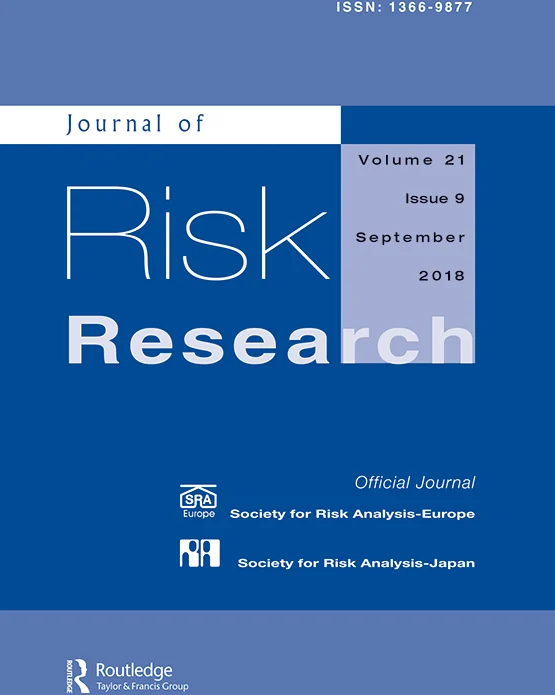A micro-place evaluation of the relationship between ‘risky places’ and risk perceptions
IF 2.4
4区 管理学
Q1 SOCIAL SCIENCES, INTERDISCIPLINARY
引用次数: 0
Abstract
Abstract The movement towards micro-place level assessments has contributed to the growing popularity of place-based police strategies. Complementing this movement, risk terrain modeling (RTM) is a methodological approach that identifies a micro-place’s vulnerability to crime by considering the combined spatial influences of physical features of the landscape linked to criminal behavior, along with past crime exposure. Given the growing popularity of this tool, studies that explore how RTM contributes to prior knowledge on crime risk are of great value. Our study is the first to expand upon previous applications of RTM by integrating the insights from the risk and decisions sciences to consider the perspective of potential crime victims. This type of evaluation can shed light on factors related to victimization and inform police strategies. To this end, our study utilizes a mixed-method approach to examine whether participants’ perceptions of risk determined from visual inspections of micro-places correspond to statistical (or objective) risk produced from a risk terrain model of robbery in downtown Detroit, Michigan. Participants were randomly assigned to receive a low, medium, or high risk micro-place, and asked to respond to a series of questions that measured their risk perceptions. Overall, participants’ perceptions of their risk of being robbed were the inverse of that predicted by our risk terrain model. Our qualitative analysis suggests that this disconnect can be largely explained by the presence of people and lighting. In a follow-up study, we alter the levels of people and lighting at low and high risk micro-places. We found that high levels of people an lighting play a dominant role in informing risk perceptions, superseding all other considerations. We discuss the implications of our findings for crime prevention, as well as our study’s limitations and directions for future research. Supplemental data for this article is available online at https://doi.org/10.1080/13669877.2021.2001672 .“风险场所”与风险认知关系的微观场所评估
摘要微观地方一级评估的发展推动了基于地方的警察战略的日益流行。作为对这一运动的补充,风险地形建模(RTM)是一种方法论方法,通过考虑与犯罪行为相关的景观物理特征的综合空间影响,以及过去的犯罪暴露,来识别微观场所对犯罪的脆弱性。鉴于该工具越来越受欢迎,探索RTM如何为犯罪风险的先验知识做出贡献的研究具有重要价值。我们的研究首次通过整合风险和决策科学的见解,考虑潜在犯罪受害者的角度,扩展了RTM以前的应用。这种类型的评估可以揭示与受害有关的因素,并为警方的战略提供信息。为此,我们的研究采用了一种混合方法来检验参与者对微观场所视觉检查确定的风险感知是否与密歇根州底特律市中心抢劫的风险地形模型产生的统计(或客观)风险相对应。参与者被随机分配到一个低、中或高风险的微型场所,并被要求回答一系列衡量他们风险感知的问题。总体而言,参与者对被抢劫风险的感知与我们的风险地形模型预测的相反。我们的定性分析表明,这种脱节在很大程度上可以通过人和灯光的存在来解释。在一项后续研究中,我们改变了低风险和高风险微型场所的人员和照明水平。我们发现,高水平的照明在告知风险认知方面发挥着主导作用,取代了所有其他考虑因素。我们讨论了我们的研究结果对预防犯罪的影响,以及我们研究的局限性和未来研究的方向。本文的补充数据可在线获取,网址为https://doi.org/10.1080/13669877.2021.2001672。
本文章由计算机程序翻译,如有差异,请以英文原文为准。
求助全文
约1分钟内获得全文
求助全文
来源期刊

Journal of Risk Research
SOCIAL SCIENCES, INTERDISCIPLINARY-
CiteScore
12.20
自引率
5.90%
发文量
44
期刊介绍:
The Journal of Risk Research is an international journal that publishes peer-reviewed theoretical and empirical research articles within the risk field from the areas of social, physical and health sciences and engineering, as well as articles related to decision making, regulation and policy issues in all disciplines. Articles will be published in English. The main aims of the Journal of Risk Research are to stimulate intellectual debate, to promote better risk management practices and to contribute to the development of risk management methodologies. Journal of Risk Research is the official journal of the Society for Risk Analysis Europe and the Society for Risk Analysis Japan.
 求助内容:
求助内容: 应助结果提醒方式:
应助结果提醒方式:


